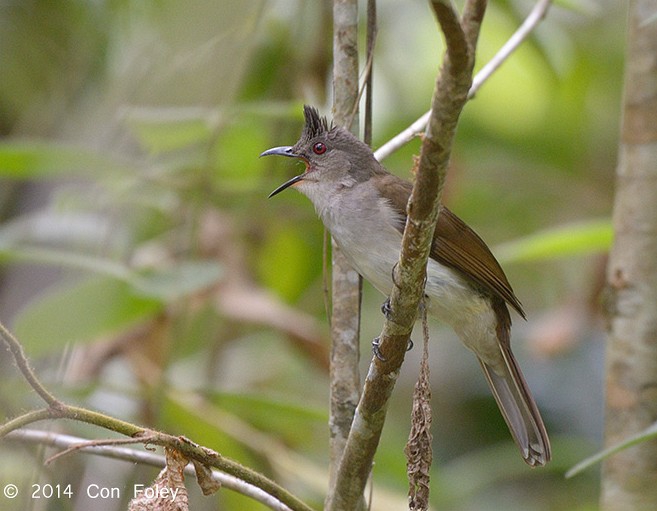| Citation |
|
Description |
Geographic Range [top]
Range Description: Pycnonotus eutilotus occurs in the Sundaic lowlands, from south Tenasserim, Myanmar, peninsular Thailand, Sabah, Sarawak and Peninsular Malaysia, Singapore (formerly), Kalimantan and Sumatra (including Bangka Island), Indonesia and Brunei (BirdLife International 2001). It is uncommon to fairly common in suitable habitat within this range.
Countries occurrence:
Native:
Brunei Darussalam; Indonesia; Malaysia; Myanmar; Thailand
Regionally extinct:
Singapore
Additional data:
? Continuing decline in area of occupancy (AOO): Yes
? Extreme fluctuations in area of occupancy (AOO): No ? Estimated extent of occurrence (EOO) - km2: 3750000
? Continuing decline in extent of occurrence (EOO): Unknown ? Extreme fluctuations in extent of occurrence (EOO): No
? Continuing decline in number of locations: Unknown
? Extreme fluctuations in the number of locations: No
Range Map: Click here to open the map viewer and explore range.
Population [top]
Population: The global population size has not been quantified, but the species is described as uncommon to locally fairly common (del Hoyo et al. 2005).
Trend Justification: This species is likely to be declining in line with rates of deforestation occurring across its range. These declines are suspected to be particularly severe, as this species is largely restricted to mature forests in the flat lowlands, where rates of habitat loss are highest. The overall rate of population decline is therefore suspected to be moderately rapid or rapid.
Current Population Trend: Decreasing
Additional data:
? Number of mature individuals: Unknown ? Continuing decline of mature individuals: Yes
? Extreme fluctuations: No ? Population severely fragmented: No
? Continuing decline in subpopulations: Unknown
? Extreme fluctuations in subpopulations: No ? All individuals in one subpopulation: No
Habitat and Ecology [top]
Habitat and Ecology: This species occurs in broadleaved evergreen forest, with most records at plains-level or on lower slopes, with an upper limit of 400 m. It is recorded in disturbed and logged forests, provided that some canopy cover remains, and also occurs in secondary forests and overgrown plantations, although potentially only in areas with adjacent primary forest.
Systems: Terrestrial
Continuing decline in area, extent and/or quality of habitat: Yes
Generation Length (years): 2.7
Movement patterns: Not a Migrant
Threats [top]
Major Threat(s): This species is largely restricted to mature forests on low-lying plains, and is therefore at a heightened risk from deforestation. Rates of forest loss in the Sundaic lowlands have been extremely rapid, owing partly to the escalation of illegal logging and land conversion, with deliberate targeting of all remaining stands of valuable timber including those inside protected areas. Forest fires have also had a damaging effect (particularly in 1997-1998).
Conservation Actions [top]
Conservation Actions: Conservation Actions Underway
No targeted conservation actions are known for this species, although it occurs in a number of protected areas.
Conservation Actions Proposed
Conduct repeated surveys within the speciess range to determine its current distribution and abundance, as well as assess population trends and rates of habitat loss. Conduct ecological studies to improve understanding of its precise habitat requirements, tolerance of secondary habitats and response to fragmentation. Effectively protect significant areas of suitable forest at key sites, in both strictly protected areas and community-led multiple use areas.
Citation: BirdLife International. 2016. Euptilotus eutilotus. The IUCN Red List of Threatened Species 2016: e.T22712702A94344035. http://dx.doi.org/10.2305/IUCN.UK.2016-3.RLTS.T22712702A94344035.en. Downloaded on 13 June 2017.
Disclaimer: To make use of this information, please check the .
Feedback: If you see any errors or have any questions or suggestions on what is shown on this page, please provide us with feedback so that we can correct or extend the information provided
|

